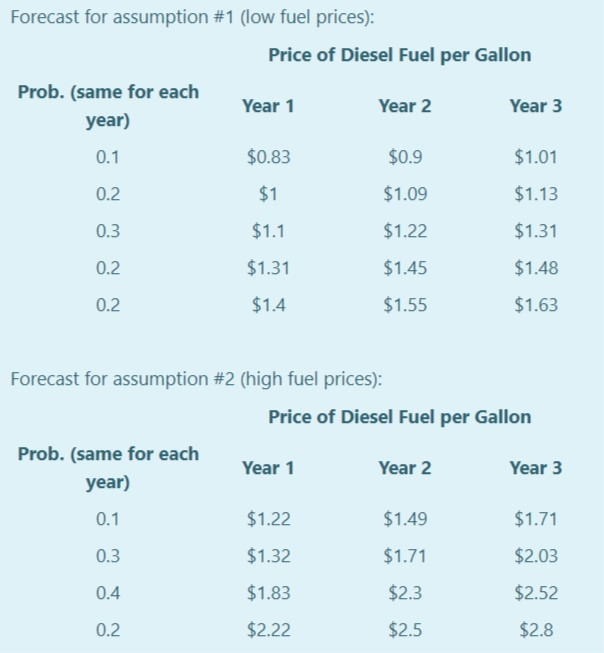Question
Five years ago, a company was considering the purchase of 60 new diesel trucks that were 14.83% more fuel-efficient than the ones the firm is
Five years ago, a company was considering the purchase of 60 new diesel trucks that were 14.83% more fuel-efficient than the ones the firm is now using. The company uses an average of 10 million gallons of diesel fuel per year at a price of $1.25 per gallon. If the company manages to save on fuel costs, it will save $1.875 million per year (1.5 million gallons at $1.25 per gallon). On this basis, fuel efficiency would save more money as the price of diesel fuel rises (at $1.35 per gallon, the firm would save $2.025 million in total if he buys the new trucks).
Consider two possible forecasts, each of which has an equal chance of being realized. Under assumption #1, diesel prices will stay relatively low; under assumption #2, diesel prices will rise considerably. The 60 new trucks will cost the firm $5 million. Depreciation will be 25.24% in year 1, 38.64% in year 2, and 36.7% in year 3. The firm is in a 41% income tax bracket and uses a 11% cost of capital for cash flow valuation purposes. Interest on debt is ignored. In addition, consider the following forecasts:

Required: Calculate the percentage change on the basis that an increase would take place from the NPV under assumption #1 to the probability-weighted (expected) NPV.
Answer % Do not round intermediate calculations. Input your answer as a percent rounded to 2 decimal places (for example: 28.31%).
Note: The educational purpose of this problem targets the students ability to read + follow instructions.
Further Information (solution steps):
Step (1): Calculate the annual expected price of diesel per gallon under each assumption, based on the probabilities outlined in the inputs section.
Step (2): Using the annual expected fuel prices calculated in step (1), determine the increase in annual savings created by the proposed efficiency for each assumption.
Step (3): Find the increased cash flow after taxes (CFAT) for both forecasts, based on the annual increase in fuel savings determined in step (2) as the increase in earnings before depreciation and taxes (EBDT), and the starting point from which profit is calculated for each assumption. As part of this step, you must establish annual depreciation (remember: depreciation is a noncash charge).
Step (4): Considering the increased annual CFAT produced in step (3), calculate the NPV of the truck purchases for each assumption, based on the discount rate (cost of capital) indicated in the inputs section
Step (5): In view of the outcomes produced in step (4), estimate the combined NPV weighed by the probability of each assumption.
Step (6): Finally, calculate the percentage difference hypothesizing that an increase took place starting from the NPV for assumption #1 to the combined NPV worked out in step (5).
Forecast for assumption #1 (low fuel prices): Price of Diesel Fuel per Gallon Prob. (same for each Year 1 Year 2 Year 3 year) 0.1 $0.83 $0.9 $1.01 0.2 $1 $1.09 $1.13 0.3 $1.1 $1.22 $1.31 0.2 $1.31 $1.45 $1.48 0.2 $1.4 $1.55 $1.63 Forecast for assumption #2 (high fuel prices): Price of Diesel Fuel per Gallon Prob. (same for each Year 1 Year 2 Year 3 year) 0.1 $1.22 $1.49 $1.71 0.3 $1.32 $1.71 $2.03 0.4 $1.83 $2.3 $2.52 0.2 $2.22 $2.5 $2.8Step by Step Solution
There are 3 Steps involved in it
Step: 1

Get Instant Access to Expert-Tailored Solutions
See step-by-step solutions with expert insights and AI powered tools for academic success
Step: 2

Step: 3

Ace Your Homework with AI
Get the answers you need in no time with our AI-driven, step-by-step assistance
Get Started


